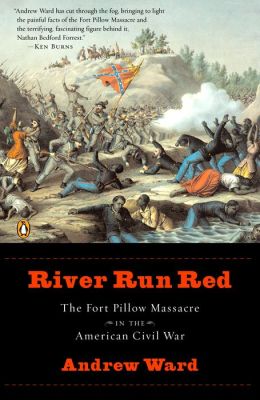
As reviewed by the Houston Chronicle , "River Run Red by Andrew Ward; Surrender to slaughter: Account of Civil War massacre is meticulously researched, by Chris Patsilelis, on 23 October 2005 -- On April 12, 1864, more than 3,000 Confederate soldiers led by Tennessee Gen. Nathan Bedford Forrest, the South's most formidable cavalry commander, attacked a Union garrison of some 500 at Fort Pillow on the Mississippi in western Tennessee. The fort's defenders comprised 200 Tennessee Unionists and more than 300 black artillerists — recently freed slaves. The ferocious massacre that ensued is the subject of Andrew Ward's meticulously researched River Run Red.
Ward, whose books include the award-winning Dark Midnight When I Rise: The Story of the Jubilee Singers, draws on a prodigious body of evidence — letters, memoirs, court records, archives — to prove that Forrest's troops did indeed commit a massacre at Fort Pillow.
After beginning with a perceptive description of slavery in the South, the author turns to the brutality of Forrest as a slavemaster before the war. He cites a New York Tribune article describing Forrest's manner of punishing stubborn slaves, which "was to compel four of his fellow slaves to ... hold the victim stretched out ... and then Bedford and his brother John would stand, one on each side, with long, heavy bull whips, and cut up their victims until the blood trickled to the ground."
Such was the racist mind-set of the future founder of the Ku Klux Klan and most of his fellow officers and men as they laid siege to the Fort Pillow garrison, which in Forrest's eyes consisted of white Tennessee turncoats and disloyal ex-slaves.

Forrest's men had the advantage over Fort Pillow's defenders within a matter of hours, Ward informs us. A series of errors on both sides led the Rebels to suspect the Federals were refusing to surrender and complicates any account of the battle. When Union Gen. William H. Bradford's soldiers, white and black, finally put up their hands, most, perhaps 400 or more, were cut down.
Blacks who tried to flee unarmed or surrender "were pelted by the shower of lead which slaughtered them by scores. They fell in piles three or four deep: heaps of bleeding, mangled bodies." A Union soldier, Ward tells us, "saw four white men and 25 negroes" shot at the fort, and "heard the rebels on all sides crying, 'Give them no quarter; kill them; kill them; it is General Forrest's orders.' "
Surrendering black troops, according to Union Cpl. William Dickey, "were shot as fast as they were seen." As one poor fellow, nearly drowned, crawled up the riverbank on his hands and knees, a Rebel soldier "put his revolver to his head, and blew his brains out."
The Fort Pillow massacre ended with about 60 blacks marched into slavery and about 100 white troops sent to languish and likely die in the notorious Confederate prison camps at Andersonville and Florence.
Perhaps overly detailed in its descriptions of troop movements, military strategy and so forth, River Run Red nevertheless is a revealing and morally necessary addition to the history of the American Civil War. (source: Houston Chronicle)



No comments:
Post a Comment